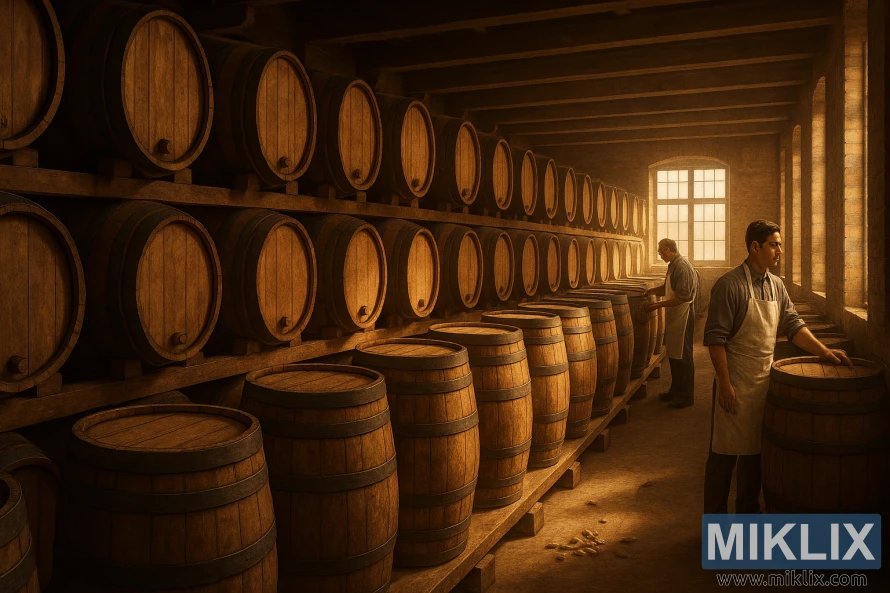Image: Munich malt storage in casks
Published: July 22, 2025 at 6:56:44 AM UTC
Last updated: September 27, 2025 at 3:35:58 PM UTC
A golden-lit warehouse with rows of wooden casks holds Munich malt, where workers monitor conditions, reflecting tradition, care, and brewing craftsmanship.
In the heart of a traditional cooperage or barrel-aging room, the scene unfolds with a quiet reverence for craftsmanship and heritage. The space is bathed in warm, natural light that streams through a large window to the right, casting golden tones across the wooden floor and illuminating the rich textures of the barrels that line the room. The interplay of light and shadow creates a painterly effect, highlighting the curvature of each cask and the subtle grain of the wood, while lending the entire space a timeless, almost sacred atmosphere. This is not merely a storage room—it is a sanctuary of fermentation and aging, where time and care converge to shape the character of what lies within.
Two rows of barrels stretch along the left wall, stacked horizontally on sturdy wooden racks. Their surfaces are darkened and worn, bearing the marks of years of use—scuffs, stains, and the occasional chalk notation that speaks to their contents and history. Each barrel is a vessel of transformation, holding within it the slow evolution of malt, beer, or spirits as they absorb the essence of the oak and the ambient conditions of the room. On the floor, another row of barrels stands upright, their rounded tops catching the light and revealing the craftsmanship of their construction: the iron hoops, the seamless staves, the precision of the joinery. These barrels are not mass-produced—they are built with intention, maintained with care, and revered for their role in the maturation process.
Amidst this orderly arrangement, two individuals move with quiet focus. Dressed in aprons, they inspect the barrels with practiced eyes and steady hands. One leans in close, perhaps listening for the subtle creak of settling wood or checking the seal of a bung. The other consults a small notebook, recording temperature and humidity levels, ensuring that the environment remains optimal for aging. Their presence adds a human dimension to the scene, reminding the viewer that behind every great brew or spirit lies the dedication of those who tend to its journey. Their movements are deliberate, their attention unwavering—a testament to the respect they hold for the process and the product.
The air in the room is thick with aroma: the earthy scent of freshly kilned malt mingles with the sweet, woody perfume of aged oak. It’s a sensory experience that evokes both the raw beginnings and the refined outcomes of brewing. The malt, likely stored nearby or already resting within the barrels, contributes its own character—rich, nutty, and slightly toasted—while the oak imparts depth, complexity, and a whisper of time. Together, they form a symphony of scent that speaks to the layered nature of the craft.
This image captures more than a moment—it encapsulates a philosophy. It is a portrait of patience, of the belief that quality cannot be rushed and that flavor is born not just from ingredients, but from environment, care, and tradition. The barrels, the light, the workers, and the space itself all contribute to a narrative of reverence and precision. It is a place where malt is not merely stored, but nurtured; where aging is not passive, but active; and where every detail—from the angle of a barrel to the temperature of the room—is part of a larger story of transformation. In this quiet, golden chamber, the spirit of Munich’s brewing legacy lives on, one cask at a time.
The image is related to: Brewing Beer with Munich Malt

